Japan
Wood Products Prices
Dollar Exchange Rates of 25th
March
2019
Japan Yen 110.63
Reports From Japan
¡¡
Business leaders pessimistic on
prospects for global
economy
In a recent survey Japanese business leaders suggested
they expect the global economy to be in worse shape in six
months and this negative mood spilled over into the
government¡¯s assessment of the economy. For the first
time in 3 years the government downgraded its economic
assessment citing the slowdown in exports to China as the
main reason.
However, the government denied the economy had fallen
into recession saying in its monthly economic report that
the economy is ¡°recovering at a moderate pace while
weakness is seen recently in exports and industrial
production in some sectors.¡±
https://www5.cao.go.jp/keizai3/getsurei-e/2019mar.html
At its most recent policy board meeting the Bank of Japan
(BOJ) was downbeat on its assessment of the economy
because of the impact of global trends on exports and the
knock-on effect on production. The BoJ opted to maintain
its current monetary policy.
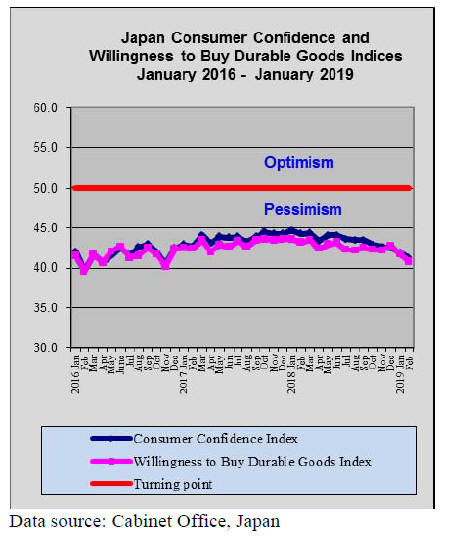
Re-shoring - a noticeable new trend in Japan
A trend has been observed in increased Japan-based
production by domestic firms which previously moved
production overseas.
The driving force for this is said to be external demand for
high-quality ¡°made in Japan¡± products along with the
decline in advantages in overseas production as wages
rise, a factor most noticeable in emerging Asian
economies.
The trend of Japanese manufacturers shifting their
production bases back to Japan from overseas, or boosting
domestic production, has been observed in several sectors.
http://www.the-japan-news.com/news/article/0005635339
Financial sector working to anticipate impact of Era
change
In Japan, the Heisei Era will end in April and a new
imperial age will begin when Crown Prince
Naruhito accedes to the Chrysanthemum Throne on the
abdication of Emperor Akihito.
The Era name is significant for Japanese as it represents
more than just a new calendar. The name for the new era,
which will remain a secret until 1 April is chosen to reflect
the mood of a period in the same way as "the '60s" is
remembered by many western countries.
The financial sector in Japan is working hard to anticipate
the impact of the new era. It is thought that exchange rates
could become more volatility, there could be a surge in
demand for cash as people prepare for the 10 day
celebratory holiday and there could be computer problems
as the new calendar is introduced on 1 May when the new
emperor is enthroned.
The announcement from the US Federal Reserve that it
will slow interest rate hikes promoted dollar sales and a
strengthening of the Japanese yen despite the gloomy
outlook for the Japanese economy.
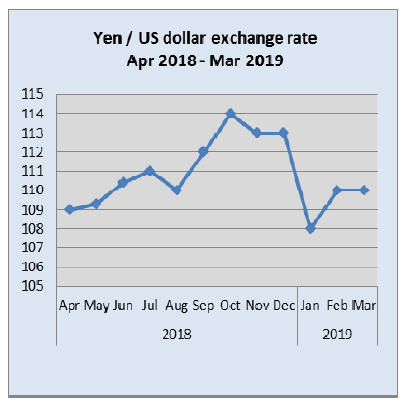
Land prices in Japan are rising
Recent data from the Ministry of Land, Infrastructure and
Tourism has confirmed that land prices in Japan are rising.
The average price of all types of land across Japan has
now risen for four consecutive years and in 2018 average
prices for residential land in rural areas increased for the
first time in 27 years.
http://www.mlit.go.jp/en/totikensangyo/totikensangyo_fr4_0000
02.html
One reason for the rise in land prices, especially in urban
areas, was buying by overseas investors mainly Chinese
and Taiwanese investors seekingrent income from offices
and apartments. However, several real estate companies
selling into this market are seeing a decline in sales.
The average price of existing apartments in Tokyo barely
increased in 2018 after the 3% plus rise the previous year.
According to the Land Institute of Japan, existing
apartment sales in Tokyo fell slightly in 2018 and sales of
existing detached homes also fell. In 2018 housing starts
were over 2% down from a year earlier.
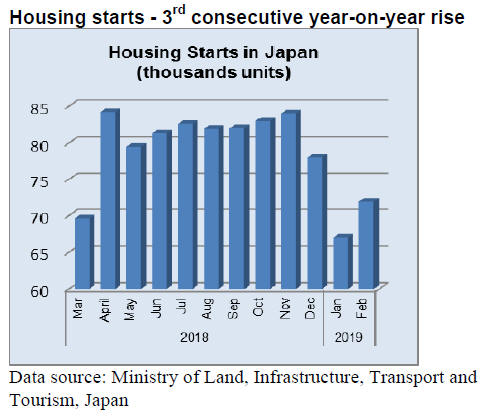
Housing starts in February rose 4% year on year to
71,966
units, the third consecutive year on year rise. The increase
was led by higher starts for owner-occupied homes and
apartment blocks.

Office furniture imports (HS 940330)
The top three shippers of wooden office furniture
(HS940330) to Japan in January were China at a huge
75% of all January imports (up 60% from a month earlier)
followed by Poland (7%) significantly up from the value
of December 2018 shipments and Portugal (4%). Together
the three top shippers accounted for 86% of all Japan¡¯s
wooden office furniture imports in January.
Year on year the value of Japan¡¯s January 2019 imports of
wooden office furniture (HS 940330) were little changed
but month on month imports rose sharply.
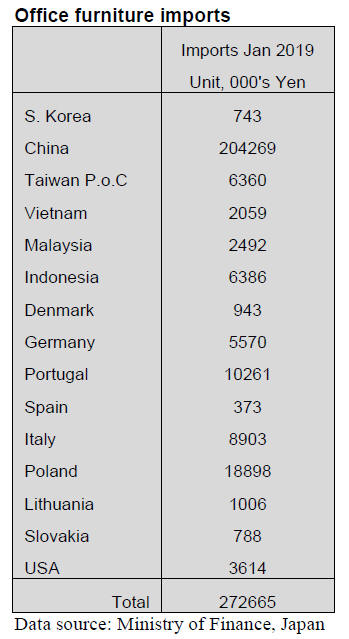
Kitchen furniture imports (HS 940340)
January data for the value of Japan¡¯s wooden kitchen
furniture imports reaffirmed the dominance of the top two
shippers, the Philippines and Vietnam which together
accounted around 95% of Japan¡¯s wooden kitchen
furniture imports in the first month of the year.
In January shipments of wooden kitchen furniture from the
Philippines topped those from Vietnam. The third largest
shipper, China, could only secure a 14% share of imports
in January. Year on year the value of January 2019
imports of wooden kitchen furniture were up 14% but
month on month there was little change. Other shippers of
note in January were Germany and Italy but the value of
shipments was small.
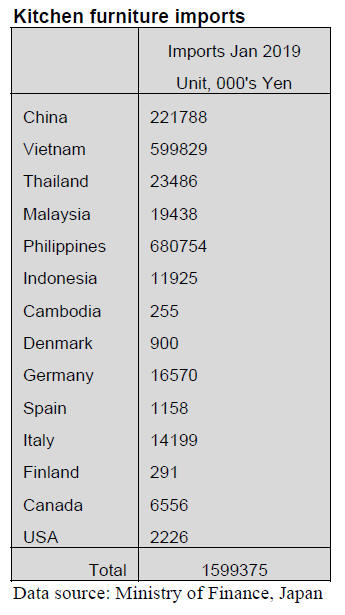
Bedroom furniture imports (HS 940350)
The value of Japan¡¯s imports of wooden bedroom
furniture (HS 940350) continue to trend higher, a trend
seen in previous years. If imports follow the same pattern
as in 2017 and 2018 the value of imports will reverse
direction to fall steadily until around September.
In January 2019, year on year the value of imports were
some 7% down but month on month there was a 15% rise
in the value of imports with the two main shippers, China
and Vietnam both seeing higher shipments. The combined
value of shipments for China and Vietnam accounted for
just over 90% of all January 2019 imports of this category
of wooden furniture.
Thailand, Malaysia and Poland are also suppliers of
wooden bedroom furniture and the combined shipments
from these three accounted for almost all of the 5%
balance.
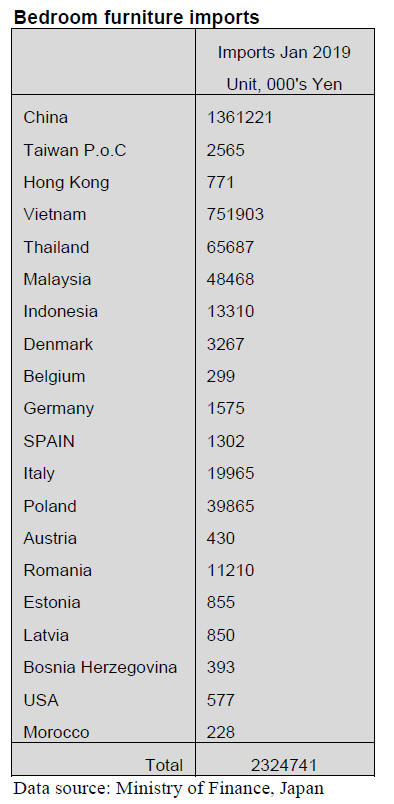
Trade news from the Japan Lumber Reports (JLR)
The Japan Lumber Reports (JLR), a subscription trade
journal published every two weeks in English, is
generously allowing the ITTO Tropical Timber Market
Report to reproduce news on the Japanese market
precisely as it appears in the JLR.
For the JLR report please see:
http://www.nmokuzai.
com/modules/general/index.php?id=7
Import of North American logs in 2018
Total log import from North American in 2018 was 2,552,
986 cbms, 2.0% less than 2017. Decline for two
consecutive years. Logs from the U.S.A. were almost the
same as 2017 while logs from Canada decreased by about
10%.
There was no serious climate factor to impact log
production in 2018 but domestic lumber market
skyrocketed in the first half of the year then plunged in the
second half so domestic log demand was strong in the first
half then got weak toward year end.in the U.S.A. but
Canada was different. Domestic demand in Canada was
strong and there was not much surplus for export.
Douglas fir logs from the U.S.A were 1,585,762 cbms,
0.2% less than 2017 then from Canada were 746,387
cbms, 9.0% less.
Total Douglas fir logs were 2,332, 149 cbms, 3.2% less
and share of Douglas fir in total North American log
import dropped to 91.3% from 92.5% in 2017.
IS sort Douglas fir log prices in January 2018 peaked at
US$1,040 per M Scribner FAS then started sliding and
down to US$870 for December shipments. Meantime,
Canadian Douglas fir log prices were US$135 in January
and climbed to US$150 by middle of 2018 and stayed high
through 2018 without dropping.
Canadian small Douglas fir logs are for plywood use in
Japan but demand by Canadian veneer plants was very
active so availability for export stayed tight. Unlike
softwood lumber, which is imposed anti-dumping duty
and countervailing duty for U.S. export, Canadian veneer
is duty free so export volume of veneer did not drop so
that Canadian veneer plants are anxious to buy suitable
logs for veneer manufacturing.
With stable supply, Douglas fir log FAS prices for Japan
dropped in late 2018 but by chronic unprofitable business
with high log cost, second largest Douglas fir sawmill in
Japan, Toa Ringyo gave up the business in late 2018 so
Toa¡¯s consuming volume of 400,000 cbms disappears this
year.
Hemlock log supply was 142,030 cbms, 23.1% more than
2017.Domestic plywood mills now consume more
hemlock due to tight supply of Canadian Douglas fir logs.
Spruce was 35,413 cbms, 5.5% more but the volume is far
smaller compared to old days so declining trend continues.
Canadian supply increased by 59.1% but U.S. supply
decreased by 40.5%. Yellow cedar was 6,653 cbms, 34.7%
less and red cedar was 6,312 cbms, 37.3% less.
Hardwood logs from the U.S.A. were 30,420 cbms, 19.9%
more. This is rebound of large drop in 2017. The arrivals
after August were much larger than usual years.
Radiata pine logs and lumber import
Total radiate pine log import from New Zealand in 2018
was 389,814 cbms, 3.3% more than 2017. This slight
increase is not by demand increase but delayed shipment
on statistic.
Actually log demand is declining by high export prices
and sawmills suffer poor profitability all through the year.
The demand of radiate pine lumber shifts to Chilean
radiate pine lumber and low cost domestic cedar lumber
from lumber sawn from New Zealand logs.
Export log prices are largely influenced by prices of export
logs for China, which is now dominant New Zealand log
buyer so the prices for Japan had been over US$150 per
cbm C&F.
Radiata pine flitch is the main item from New Zealand,
which is mainly used for cable drum. Demand of cable
drum was active for restoration of flood and landslide
damages in Western Japan and also busy orders from
overseas countries but the supply was unstable.
Import of Chilean radiate pine lumber in 2018 was
333,430cbms, 15.6% more than 2017. With active demand
of crating lumber all through the year, there was no supply
glut despite increased supply but in late 2018, the demand
of crating lumber started dropping after Chinese economy
started slowing down by trade war with the U.S.A.
Export cargoes from Japan to China started deceasing so
that crating lumber demand decreased. Robust orders for
Chilean lumber faded. Export prices of Chilean lumber
had been firm and with weaker yen, the importers needed
to increase the sales prices by about 1,000 yen per cbm.
Composite flooring in 2018
Production of composite flooring in 2018 was 63,948,720
square meters, 5.5% less than 2017. This is decline of two
straight years. The shipment was also dropped down to
66,327,690 square meters, 7.4% less. The decline is
proportionate to decline of new housing starts. By base
materials, 21,379,710 square meters of imported plywood
with MDF, 2.6% less and 16,215,870 square meters of
imported plywood, 10.6% less.
On the other hand, domestic plywood and MDF base
increased to 16,426,080 square meters, 2.9% more. This is
due to unstable supply of imported plywood and many
floor manufacturers shifted todomestic plywood from
imported plywood. Particleboard base was 5,752,230
square meters, 1% less and MDF base was 3,860,340
square meters, 31.5% less.
For surface materials, thin sliced wood was 2,342,175
square meters, 12.9% less and decorative sheet is
40,526,970 square meters, 0.6% less.
Base material of imported plywood for wood veneer
surface is 36% but the production dropped largely to
8,456,900 square meters. Meantime, majority of base
materials of decorative surface sheet is combination of
imported plywood and MDF, which production increased
to 13,769,580 square meters, 4.2% more and combination
of domestic plywood and MDF also increased to
11,023,980 square meters, 4.8% more.
Demand of composite base materials with low cost and
stable supply has been increasing after South Sea
hardwood plywood supply gets tight and the prices are
soaring.
Plywood
Movement of both domestic and imported plywood is
getting slower now. February is demand slow month and
dealers are watching the market closely while the
manufacturers are trying to raise the sales prices to prevent
dealers from dropping the prices.
Imported plywood cost continues high so both domestic
and imports have no room to reduce the prices. Since
March is book closing month, the dealers are caught in
between maintaining the prices and disposition of the
inventories.
Softwood plywood production in January was 247,500
cbms, 0.8% more than January last year and 2.1% less
than December.
Shipment of softwood plywood in January was 271,300
cbms, 7.6% more and 5.1% more. With lengthy New
Year¡¯s holidays, January production dropped but the
shipment was busy because deliveries in December
delayed by shortage of trucks, which were shipped in late
January so the shipment volumewas more than 270,000
cbms. The inventories dropped down to 132,600 cbms,
23,000 cbms less than December.
This is four straight months decline of the inventories.
Orders for precutting plants in the Eastern Japan are down
except for large plants but the movement in Western Japan
is rather busy and mills¡¯ inventory of 12 mm thick panel is
tight and the prices stay firm.
In Tokyo market, the prices fluctuate in March as smaller
dealers try to dispose of the inventories before book
closing and the manufacturers tell dealers that they will
hold the prices adamantly to tighten the market.
In imported plywood, market prices of thin and medium
thick panel are weakening after the export prices softened.
Some dealers are offering lower prices on 12 mm thick
panel in stagnant market but majority of inventories are
high priced items now so it is unlikely that large volume of
low priced is offered.
The importers are well aware that 12 mm panel export
prices continue firm and strong so they need to maintain
present sales prices. Facing higher export prices, the
importers are not able to go after future cargoes.
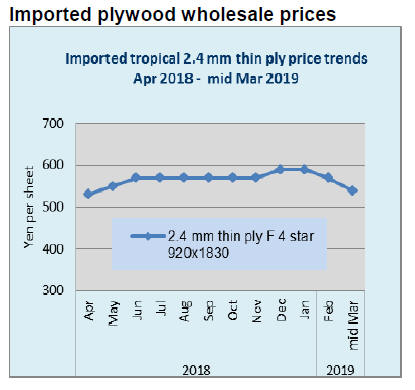 
Major log exporting ports
Total log export by Japan in 2018 was 1,157,438 cbms,
19.3% more than 2017. According to trade statistics the
Ministry of Finance made, top log exporting port is
Shibushi (Kagoshima prefecture) Kyushu with 372,000
cbms, 24.2% more than 2018.
Shibishi has been top exporting port for last nine years. Up
until 2017, port with the volume exceeding 100,000 cbms
was Shibushi only but in 2018, three ports shipped more
than 100,000 cbms. They are Saheki, Hososhima and
Yatsuhsiro, all in Kyushu.
Chinese demand was mainly construction and engineering
works but such demand is peaking now and new demand
is crating boxing lumber for transporting machine and
home appliances.
Also China has been shipping exterior lumber like fencing
and decking made from Japanese cedar and China rushed
exporting such lumber before import duty is raised, which
stimulated cedar log purchase in 2018.
China has been buying large volume of Southern Yellow
pine logs from the U.S.A. but this will slow down by high
export duty so China needs substituting source of log
purchase so it will continue buying Japanese cedar logs as
long as the prices are competitive with New Zealand
radiata pine log prices.
Lumber export in 2018 was 145,995 cbms, 12.3% more
than 2017. The volume for Taiwan P.o.C and the U.S.A.
increased. Particularly lumber for the U.S.A. increased by
74.6%, which is mainly exterior cedar lumber like fencing
and decking.
Taiwan P.o.C volume also increased by 78.5% and the
main species is cypress. However, the export prices are
almost the same as domestic sales prices so after deducting
freight and marine insurance, it is not profitable business.
|